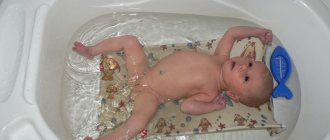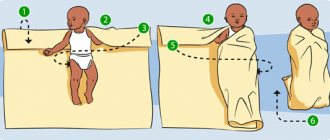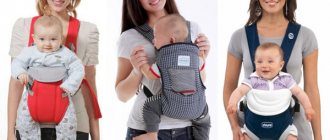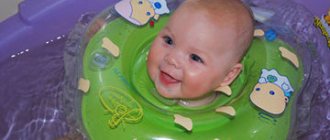When an expectant mother packs her things for the maternity hospital, she always packs a pile of warm and thin diapers according to the list. But after the baby is born, the question arises whether it is necessary to swaddle the baby. After all, now you can buy beautiful and comfortable bodysuits, slips, and overalls that will not hinder the baby’s movements. Mothers and grandmothers advise swaddling babies, as they did in their time. But parents must make a decision regarding swaddling a newborn based on their own convenience, financial capabilities and characteristics of the baby.
We'll figure out whether swaddling is necessary and give some advice to parents.
Types of swaddling - how to swaddle a baby
There are 4 known methods of swaddling a newborn baby:
- Tight. The baby is swaddled “hands and feet”, with his legs and arms extended along the body to limit movements as much as possible. The method is not welcomed by specialists (the majority of them).
- Free. In this case, only the legs are swaddled (not tightly), while the arms are left free. Or they “pack” the baby into a spacious envelope. A gentle option for the child’s comfort and prevention of hip dysplasia.
- Wide. The method is used for orthopedic problems in a child or for disorders of muscle tone. The natural pose for a child is bent legs. Between them is a diaper or special panties. Next - either tight or loose swaddling.
- Natural. That is, no diapers - only rompers and undershirts for complete freedom of the little gnome.
How to wrap your baby in a blanket for discharge
Discharge from the maternity hospital has its own characteristics. The baby must be wrapped in such a way as to provide good support for the spine and head, because people who do not have the appropriate skills will pick up a newborn. In addition, the swaddling method should allow you to cover the baby's face without restricting breathing.
photo from the site https://www.youtube.com
It is also necessary to take into account the solemnity of the moment, so you need to wrap the newborn in a blanket beautifully and securely, so that during the process of meeting relatives the envelope does not fall apart. You need to proceed as follows:
- Lay a ribbon on the changing table and a blanket diagonally over it. The corners should be directed towards the baby's head and legs.
- Spread a diaper with a lace corner on top of the blanket so that the decorative part matches the corner oriented towards the baby's head.
- Lay your baby down diagonally, making sure there are no folds under the backrest that could cause discomfort.
- Fold the top corner as shown in the photo, forming a roll around the head. This way you will create an air pocket and will not allow the folded corner to fit tightly to your face.
- Press your left arm to your body and wrap the edge of the blanket to your right tightly around your body, fixing your arm in this position.
- Tuck the remaining free section of the right corner under the back and smooth out the folds. Make sure that the top edge clasps the shoulder, this will additionally protect against the handle being pulled out.
- Fold the bottom corner up and under the right shoulder. Don't forget to straighten the legs first so that there is enough space for them in the envelope.
- Wrap the left corner of the blanket tightly around the baby and secure the envelope with tape.
This way you can either wrap your newborn in a blanket for discharge or for a walk in cold weather. The resulting envelope protects the body, neck, and head of the baby from freezing. If you plan to put your child in a stroller, then you can do without the tape; the fixing factor in this case is the cover and the child’s weight.
Pros and cons of tightly swaddling a newborn – should you swaddle your baby tightly?
Today people are talking more and more loudly about the dangers of swaddling. Despite the Russian tradition of swaddling a baby to “mitigate labor stress,” modern mothers doubt the correctness of the method .
And there are grounds for doubt.
Disadvantages and consequences of tight swaddling, according to scientific medicine:
- Inhibition of the development of motor functions of the baby.
- Risk of developing hip dysplasia.
- Poor circulation and compression of the lungs.
- Overheating and decreased immunity.
- Deterioration of the baby’s sleep and well-being due to a violation of his usual physiological position (fetal position).
- Psychological consequences: passivity and weak character in the future. Tight swaddling is a kind of “stub” for the instinct of freedom.
- Difficulties in the further development of speech functions.
- Lack of tactile sensations (one of the most important sensory channels responsible for the child’s psychological sensitivity in the future).
- Weakening of muscles, joints and ligaments due to weak gastrointestinal tract function, slow development of the lungs and heart, slow metabolism and poor circulation.
- Higher risk of developing pneumonia or sudden death syndrome.
- Overloaded nervous system. During sleep, when movements are limited, the brain has difficulty processing all the information that was received during the day.
- The same position throughout the night is not good for the health of the baby. It’s good if the mother turns the baby over every hour and a half - first on one side, then on the other. And if not? Try spending the whole night tightly wrapped in a sheet on one side. What can we say about the situation when the baby sleeps on his back all night, unable to move: after regurgitating milk, he may simply choke.
Myths about tightly swaddling a newborn:
- “The method will help straighten your legs.” Unfortunately no. Will not help. And curvature of the legs, by the way, is caused by vitamin D deficiency and rickets.
- “The baby is warm in a diaper, and there is a lower risk that he will get sick.” Vice versa. With tight swaddling, adaptation to temperature changes becomes difficult, and in winter, overheating even occurs. As a result, instead of hardening, there is anti-hardening.
- “The baby is more comfortable in a diaper.” This is what mom thinks when the tightly swaddled baby finally falls asleep. In fact, the baby falls asleep, “giving up” - unable to resist his mother’s insistence. And the natural position for him is the fetal position. That is, free movement of arms and legs.
- “The tighter you swaddle, the more soundly you will sleep.” The issue is controversial and individual. Most children are just trying to break out of the diaper captivity in order to suck a finger or at least move. Read also: Why does my baby sleep poorly at night?
- “The baby wakes himself up at night with his hands if he is not swaddled.” A tightly swaddled baby wakes up during the night even more often than a loosely swaddled baby. Because he gets tired from one pose.
- "The child scratches himself." If you trim your nails correctly, you don’t have to worry about this problem. As a last resort, you can always buy “scratches”.
What do other experts say in favor of tight swaddling?
- Thanks to tight swaddling, the deep sleep phase increases.
- In a diaper cocoon, the baby calms down faster (this advantage is more likely for the mother).
- Diapers are cheaper than rompers and vests.
- Swaddling helps when teeth are being cut.
- It is easier to transfer a tightly swaddled baby into a crib from his mother’s sofa without waking him up.
With the exception of the first point, all the “advantages” of tight swaddling boil down to the mother’s peace of mind and saving money, effort and time.
How to wean yourself off swaddling
A child who has been wrapped in cloth since birth must be gradually accustomed to normal clothing. To begin, put on a sleepsuit or a vest with rompers and leave your baby in the clothes for several hours. During the weaning period at night, it is advisable to continue swaddling the baby, otherwise sleep may be interrupted and restless.
Wrap an overexcited child in a blanket or blanket and rock him a little in your arms. When the baby is sick, as well as during teething, this method can also be used.
Each mother decides for herself what her baby will wear.
The main thing is peace of mind and physical comfort of all family members. If you are comfortable swaddling, do it correctly and do not listen to opponents of this method. If you want to dress your baby in beautiful clothes, do as you see fit. leave a comment
What is the benefit of such swaddling?
- Comfort for the child and the ability to take a natural position while sleeping. The space is clearly limited, but without the “straitjacket” effect of tight swaddling - the baby is calm internally and physically comfortable.
- Tactile sensations. The baby can feel the diaper fabric with both arms and legs. Which contributes to the development of the sense of touch.
- The baby can sleep on his side and even on his tummy.
- The child develops correctly (fine motor skills, tactile sensations, etc.).
- The baby begins to walk earlier.
- There is less inflammation and irritation on the baby's skin , thanks to free air circulation and maintaining normal temperature inside the diaper, without overheating and the greenhouse effect.
- The lungs work in full, blood circulation is not impaired, the blood is fully saturated with oxygen.
- Free swaddling is the first stage of hardening and, accordingly, strengthening the immune system.
Until what age can a baby be swaddled?
If parents have finally decided on diapers, they are faced with a reasonable question: up to what age can a baby be swaddled. Here you need to focus on the baby’s developmental level. For several months after birth, the baby feels protected in a fabric cocoon. It’s as if he is in his mother’s womb, where he was calm and comfortable for nine months.
After some time, the baby begins to actively move, explore the world, and his legs and arms should not be constrained. Children at three months are moving their limbs with all their might, looking around, learning to grab toys and other objects. Swaddling at this age will hinder the baby's full development. At six months, babies acquire many active motor skills, and the need for swaddling completely disappears.
Free swaddling technique for a newborn, video - when and how to swaddle a baby?
You can swaddle your baby freely in any situation that allows this possibility: at night, during a walk in the summer, in an envelope in the winter, while feeding, etc.
From 2-3 months, the baby can already be swaddled only during nighttime sleep.
The technique of free swaddling a baby is simple:
- Put on the baby a vest in accordance with the room temperature + a diaper.
- Place the child on top of the diaper (the top edge of the diaper is at lumbar level) so that the arms remain “free” during swaddling.
- Wrap the baby by tucking first the left and then the right edge of the diaper under the baby.
- Gently straighten the bottom edge of the diaper so that there are no wrinkles, and wrap it over the baby’s legs. Tuck the side ends of the diaper along the sides or behind the baby's back.
What you need to remember about the rules of free swaddling - a note for mothers:
- If the room is warm, then a thin vest is enough. You can also take a thin diaper.
- The most comfortable diapers are knitted ones. They create a comfortable microclimate for the baby, allow air to pass through, leave space for movement and are most conveniently fixed.
- Instead of a diaper, you can use an envelope made of thin fabric - a “sleeping bag” for a baby.
Some facts from history
Babies have been swaddled since ancient times. Archaeologists have found stone bas-reliefs from ancient Rome that depict newborn babies wrapped in a piece of cloth. There is also evidence confirmed by historians that babies were swaddled by the peoples of the North and American Indians. In the time of Hippocrates, they first swaddled each part of the baby’s body, and then wrapped it entirely in cloth. In Europe in the Middle Ages, babies were wrapped in a long piece of cloth, the size of which could reach seven meters.
At all times, there have also been opponents of swaddling babies. The physician Pliny, who lived in Ancient Greece, said that it was unwise to restrict the movements of a newborn child. Russian writer Leo Tolstoy, as well as philosopher Jean-Jacques Rousseau, also opposed swaddling.
Children were swaddled to protect their bodies from the cold. In addition, it helped to leave the baby in the cradle and not be afraid that he would roll over and fall out. As a rule, they swaddled tightly during the cold season, and in the summer children were often completely undressed.










